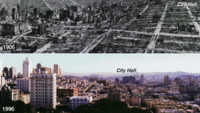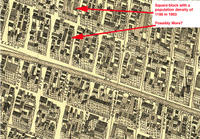 The HBO special on Rome has me jazzed up. I'm learning all about atriums, compluviums and impluviums. In this slide show I used the text from a thinkquest site (which usually can be counted on to have material written so kids can understand) with images I acquired from suggested text references. From there screen shots are used to convert for slide show content. Here's the result.
The HBO special on Rome has me jazzed up. I'm learning all about atriums, compluviums and impluviums. In this slide show I used the text from a thinkquest site (which usually can be counted on to have material written so kids can understand) with images I acquired from suggested text references. From there screen shots are used to convert for slide show content. Here's the result.
Wednesday, August 31, 2005
The House I Live In: Rome 2
 The HBO special on Rome has me jazzed up. I'm learning all about atriums, compluviums and impluviums. In this slide show I used the text from a thinkquest site (which usually can be counted on to have material written so kids can understand) with images I acquired from suggested text references. From there screen shots are used to convert for slide show content. Here's the result.
The HBO special on Rome has me jazzed up. I'm learning all about atriums, compluviums and impluviums. In this slide show I used the text from a thinkquest site (which usually can be counted on to have material written so kids can understand) with images I acquired from suggested text references. From there screen shots are used to convert for slide show content. Here's the result.
Dollhouses
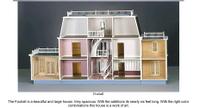 A great craft project for "The House I Live In." All you need is patience and a glue gun and a generous funder to supply the kits. Get working on it Lenny. Here's a dollhouse slide show
A great craft project for "The House I Live In." All you need is patience and a glue gun and a generous funder to supply the kits. Get working on it Lenny. Here's a dollhouse slide show
Roman Villa
 from viaavgvsta.anonai.com: "The Roman villa Torre Llauder (Mataró, El Maresme) was built during the reign of the Emperor Augustus and went through significant transformations in later times. Most of the structures preserved can be dated from Severan times (late 2nd-early 3rd c. AD) and the virtual reconstruction shown here is based upon these. It must be said from the start that we have only dealt with the stately or "urban" part of the villa (the so-called pars urbana). An attempt to reconstruct the area for agricultural works (pars rustica) would have been too tentative, as there is not enough evidence preserved." Here is this excellent site as a pdf file
from viaavgvsta.anonai.com: "The Roman villa Torre Llauder (Mataró, El Maresme) was built during the reign of the Emperor Augustus and went through significant transformations in later times. Most of the structures preserved can be dated from Severan times (late 2nd-early 3rd c. AD) and the virtual reconstruction shown here is based upon these. It must be said from the start that we have only dealt with the stately or "urban" part of the villa (the so-called pars urbana). An attempt to reconstruct the area for agricultural works (pars rustica) would have been too tentative, as there is not enough evidence preserved." Here is this excellent site as a pdf file
More House Books
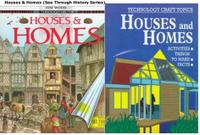 On order from half.com. Here are reviews: Houses & Homes (See Through History Series) [Hardcover] by Wood, Tim, Grade 4-6?A historic overview of domestic architecture from the modest to the extravagant. Beginning with prehistoric hunting camps and ending with Biosphere 2, the author presents a good representation of cultures throughout the world, including generic forms of housing (cave dwellings, Roman apartments, a Maori Pa, Zulu homes) as well as specific palaces (Sargon's palace in Assyria, Chambord in France). Two-to-six pages are devoted to each type of abode and examine who lived there, building materials and constructions, special or unique design features, and, in some cases, provide layouts of the surrounding community. Colorful illustrations of the homes and communities, some photographs of domestic artifacts, and cutaways and diagrams further illuminate how people lived. Four overlays add another dimension by presenting both exteriors and interiors of specific dwellings. This is a well-written and well-organized presentation that will fascinate readers.
On order from half.com. Here are reviews: Houses & Homes (See Through History Series) [Hardcover] by Wood, Tim, Grade 4-6?A historic overview of domestic architecture from the modest to the extravagant. Beginning with prehistoric hunting camps and ending with Biosphere 2, the author presents a good representation of cultures throughout the world, including generic forms of housing (cave dwellings, Roman apartments, a Maori Pa, Zulu homes) as well as specific palaces (Sargon's palace in Assyria, Chambord in France). Two-to-six pages are devoted to each type of abode and examine who lived there, building materials and constructions, special or unique design features, and, in some cases, provide layouts of the surrounding community. Colorful illustrations of the homes and communities, some photographs of domestic artifacts, and cutaways and diagrams further illuminate how people lived. Four overlays add another dimension by presenting both exteriors and interiors of specific dwellings. This is a well-written and well-organized presentation that will fascinate readers.Houses & Homes Projects Gr 3-6-What makes this title unique is that besides providing factual information on ancient, medieval, and modern houses and homes, it gives instructions for making models of five different dwellings and a solar heater. The projects include easy-to-understand directions, easy-to-find materials, outstanding full-color illustrations and photographs, and enough information to motivate readers. An interesting and usable resource for crafts, design, and technology collections.
Roman Forsphayze
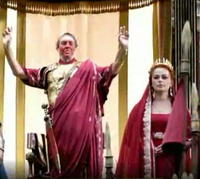 translation: appetizer, but in this version of Rome it wasn't nova scotia lox or chopped liver, but more likely some pagan sacrifice Here's a snapzpro clip from the hbo site
translation: appetizer, but in this version of Rome it wasn't nova scotia lox or chopped liver, but more likely some pagan sacrifice Here's a snapzpro clip from the hbo site
Tuesday, August 30, 2005
The House I Live In: Rome
 The HBO Rome series is excellent. There were great pains to be historically accurate and Polly Walker is worth the price of admission alone. Digitizing will allow editing out the violence and nudity. HBO has several behind the scenes clips for historical perspective and the web site has much of value. Any 6th grade class that wants to take on the home theme and stay within the 6th grade scope and sequence would be well advised to go with Ancient Rome. Here's the 6th grade content by the books: Grade 6: The Eastern HemisphereThe grade 6 social studies program emphasizes the interdependence of all people, keying on the Eastern Hemisphere. Many of the lessons and activities for this grade level draw on specific examples of nations and regions in the Eastern Hemisphere chosen by the district. It is highly recommended that lessons also compare and contrast this specific information with similar data from the United States, Canada, and Latin America. The grade 6 program focuses on a social science perspective emphasizing the interaction of geography and economics. The core disciplines of geography and economics are used to develop and draw relationships and understandings about social/cultural, political, and historic aspects of life in the Eastern Hemisphere. Historical insights are used as a means of developing a total perspective rather than on organizing framework. The focus should be on major turning points that segue into the 7th-grade social history of the United States. Each district has a responsibility for extending the student’s content examples from cultures other than the student’s own, and from a variety of geographic, socioeconomic, ethnic, and racial groups. History of Eastern Hemisphere nations
The HBO Rome series is excellent. There were great pains to be historically accurate and Polly Walker is worth the price of admission alone. Digitizing will allow editing out the violence and nudity. HBO has several behind the scenes clips for historical perspective and the web site has much of value. Any 6th grade class that wants to take on the home theme and stay within the 6th grade scope and sequence would be well advised to go with Ancient Rome. Here's the 6th grade content by the books: Grade 6: The Eastern HemisphereThe grade 6 social studies program emphasizes the interdependence of all people, keying on the Eastern Hemisphere. Many of the lessons and activities for this grade level draw on specific examples of nations and regions in the Eastern Hemisphere chosen by the district. It is highly recommended that lessons also compare and contrast this specific information with similar data from the United States, Canada, and Latin America. The grade 6 program focuses on a social science perspective emphasizing the interaction of geography and economics. The core disciplines of geography and economics are used to develop and draw relationships and understandings about social/cultural, political, and historic aspects of life in the Eastern Hemisphere. Historical insights are used as a means of developing a total perspective rather than on organizing framework. The focus should be on major turning points that segue into the 7th-grade social history of the United States. Each district has a responsibility for extending the student’s content examples from cultures other than the student’s own, and from a variety of geographic, socioeconomic, ethnic, and racial groups. History of Eastern Hemisphere nationsH1. Time can be measured in years, decades, centuries, and millennia.
H2. Key tuning points and events in the histories of Eastern Hemisphere nations can be organized into different historical time periods. The study of Eastern Hemisphere nations should include
countries from each continent.
H3. Different peoples may view the same event or issue from different perspectives.
H4. The Neolithic revolution was a technological development that radically changed the nature of human society.
H5. As the river civilizations of the Eastern Hemisphere (Mesopotamia, Egypt, China, and the Indus valley) turned to agriculture, world populations grew. (Focus on two of these.)
Cities
 The education story of yesterday ("the houses are different") was flippant in regard to middle class attitudes towards public education. These problems are complex and are linked to all kinds of historic socio-economic factors and a current political system that purposefully undermines public education. People run to avoid the underclass, but they depend on them in capitalist societies to do all the dirty little jobs that no one wants to do. View the HBO series Rome for a historical perspective. The great wealth of Rome? Supposedly 70% of Rome consisted of slaves. Yet despite that universal attitude in cities, what makes San Francisco so vibrant (if you have money) and others so stagnant? I tried to figure out what makes San Francisco unique. Why all the hills, when other cities that had hills were leveled-Seattle as an example. Even Manhattan was hilly. I asked a local elder and she said that city codes were more stringent (there were both a city and county overlap in this regard) and this restricted land development. Also, the earthquakes required certain building codes that worked against large scale development. Maybe once you got deeper into the twentieth century and people accumulated sufficient wealth in so many of the beautiful old houses, they could afford to reject offers to sell out to commercial interests. Joel Kotkin the author of "Cities, A Global History," was on Leonard Lopate's show today. He mentioned that San Francisco was unique in that it had one of the largest rentier classes, i.e. people wealthy enough to live off there interest. Therefore, San Francisco doesn't have to depend on local business as a tax base. Here's a slide show consisting of neighborhood descriptions, from the SF Examiner, alternating with Google Map views. "Whatever happened to predictibility?"
The education story of yesterday ("the houses are different") was flippant in regard to middle class attitudes towards public education. These problems are complex and are linked to all kinds of historic socio-economic factors and a current political system that purposefully undermines public education. People run to avoid the underclass, but they depend on them in capitalist societies to do all the dirty little jobs that no one wants to do. View the HBO series Rome for a historical perspective. The great wealth of Rome? Supposedly 70% of Rome consisted of slaves. Yet despite that universal attitude in cities, what makes San Francisco so vibrant (if you have money) and others so stagnant? I tried to figure out what makes San Francisco unique. Why all the hills, when other cities that had hills were leveled-Seattle as an example. Even Manhattan was hilly. I asked a local elder and she said that city codes were more stringent (there were both a city and county overlap in this regard) and this restricted land development. Also, the earthquakes required certain building codes that worked against large scale development. Maybe once you got deeper into the twentieth century and people accumulated sufficient wealth in so many of the beautiful old houses, they could afford to reject offers to sell out to commercial interests. Joel Kotkin the author of "Cities, A Global History," was on Leonard Lopate's show today. He mentioned that San Francisco was unique in that it had one of the largest rentier classes, i.e. people wealthy enough to live off there interest. Therefore, San Francisco doesn't have to depend on local business as a tax base. Here's a slide show consisting of neighborhood descriptions, from the SF Examiner, alternating with Google Map views. "Whatever happened to predictibility?"
The House I Live In: Keesha's House
 Continuing with the DARE thread with poetry: "Grade 9 Up-Frost has taken the poem-story to a new level with well-crafted sestinas and sonnets, leading readers into the souls and psyches of her teen protagonists. The house in the title isn't really Keesha's; it belongs to Joe. His aunt took him in when he was 12, and now that he's an adult and the owner of the place, he is helping out kids in the same situation. Keesha needs a safe place to stay-her mother is dead; her father gets mean when he drinks, and he drinks a lot. She wants to stay in school, all these teens do, and Keesha lets them know they can stay at Joe's. There's Stephie, pregnant at 16, and terrified to tell anyone except her boyfriend. Harris's father threw him out when his son confided that he is gay. Katie's stepfather has taken to coming into her room late at night, and her mother refuses to believe her when she tells. Carmen's parents have run off, and she's been put into juvie for a DUI. Dontay is a foster kid with two parents in jail. Readers also hear from the adults in these young people's lives: teachers, parents, grandparents, and Joe. It sounds like a soap opera, but the poems that recount these stories unfold realistically. Revealing heartbreak and hope, these poems could stand alone, but work best as a story collection. Teens may read this engaging novel without even realizing they are reading poetry.
Continuing with the DARE thread with poetry: "Grade 9 Up-Frost has taken the poem-story to a new level with well-crafted sestinas and sonnets, leading readers into the souls and psyches of her teen protagonists. The house in the title isn't really Keesha's; it belongs to Joe. His aunt took him in when he was 12, and now that he's an adult and the owner of the place, he is helping out kids in the same situation. Keesha needs a safe place to stay-her mother is dead; her father gets mean when he drinks, and he drinks a lot. She wants to stay in school, all these teens do, and Keesha lets them know they can stay at Joe's. There's Stephie, pregnant at 16, and terrified to tell anyone except her boyfriend. Harris's father threw him out when his son confided that he is gay. Katie's stepfather has taken to coming into her room late at night, and her mother refuses to believe her when she tells. Carmen's parents have run off, and she's been put into juvie for a DUI. Dontay is a foster kid with two parents in jail. Readers also hear from the adults in these young people's lives: teachers, parents, grandparents, and Joe. It sounds like a soap opera, but the poems that recount these stories unfold realistically. Revealing heartbreak and hope, these poems could stand alone, but work best as a story collection. Teens may read this engaging novel without even realizing they are reading poetry.
The House I Live In: This Is The House That Crack Built
 The house theme for DARE education? "A familiar nursery rhyme takes a decidedly dark turn in this sobering picture book. Written in a hip - hop rhythm and based on "The House That Jack Built," the new cumulative rhyme focuses attention on the drug trade and abuse of crack cocaine. No stone is left unturned as the text demonstrates the drug's ripple effect that begins with exploited South American coca farmers--"These are the Farmers who work in the heat"--and ends up invading urban neighborhoods also infested with gangs, violence, despair and hopelessness: "This is the Street of a town in pain"; "This is the Girl who's killing her brain." Dicks uses muted, somber colors and almost cubist figures and images to illustrate crack's lethal potential. The picture book format is well-suited to presentation of this subject matter to a wide audience--younger readers can readily digest the sparse text and ask questions about the art, while older children and adults may use the book as a jumping off point for more involved discussion. All of the publisher's proceeds from the book will go to drug education, prevention and rehabilitation programs that specifically help children. All ages.
The house theme for DARE education? "A familiar nursery rhyme takes a decidedly dark turn in this sobering picture book. Written in a hip - hop rhythm and based on "The House That Jack Built," the new cumulative rhyme focuses attention on the drug trade and abuse of crack cocaine. No stone is left unturned as the text demonstrates the drug's ripple effect that begins with exploited South American coca farmers--"These are the Farmers who work in the heat"--and ends up invading urban neighborhoods also infested with gangs, violence, despair and hopelessness: "This is the Street of a town in pain"; "This is the Girl who's killing her brain." Dicks uses muted, somber colors and almost cubist figures and images to illustrate crack's lethal potential. The picture book format is well-suited to presentation of this subject matter to a wide audience--younger readers can readily digest the sparse text and ask questions about the art, while older children and adults may use the book as a jumping off point for more involved discussion. All of the publisher's proceeds from the book will go to drug education, prevention and rehabilitation programs that specifically help children. All ages.
The House I Live In: Everett Shinn
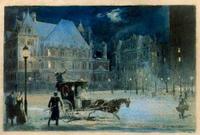 Another of the ashcan artists who gave us a view of the reality of the street life of New York City 100 years ago: "EVERETT SHINN (1876-1953) played a many sided role in American art. As a member of the "Ash Can School," his pastels of New York street scenes ranged from park avenue to the Bowery. His early experience as a newspaper artist-reporter gave him great technical facility which he later exercised as an illustrator for many national magazines such as McClure's, Hearsts International, Everybody's and The Century. Here's a slide show of Shinn's work
Another of the ashcan artists who gave us a view of the reality of the street life of New York City 100 years ago: "EVERETT SHINN (1876-1953) played a many sided role in American art. As a member of the "Ash Can School," his pastels of New York street scenes ranged from park avenue to the Bowery. His early experience as a newspaper artist-reporter gave him great technical facility which he later exercised as an illustrator for many national magazines such as McClure's, Hearsts International, Everybody's and The Century. Here's a slide show of Shinn's work
Monday, August 29, 2005
Home for the Homeless
 Looks like a perfect fit for a teacher like Ms. Adorno: "Kindergarten-Grade 4-- In both a literary and artistic sense, this collection is stronger than many books created to benefit a cause. The theme is broadly interpreted. Franz Brandenberg writes of a young child playing in bed--``I am the king in my castle./I am a mole in a hole.''--while Arthur Yorinks gives a jazzy, prose poem about the refrigerator: ``What a place to live the refrigerator is, that is, if you're a cucumber.'' From Lucille Clifton there is a simple, yet poignant piece about being at home in an elevator stuck between floors: `` . . . home/ is a corner/ where i crouch/ safe/ reading/ waiting . . . .'' Generally the work of authors and illustrators is complementary, making the variety of visual styles and typefaces interesting rather than jarring. Some selections are somewhat above the intended age range for this brief, lavishly illustrated format: Lawrence Yep and Cynthia Rylant's vignettes about their grandparents, although simply and vividly told, are more adult reminiscences, better suited to older readers; Jamake Highwater's poem is quite sophisticated. The subject is of interest to all ages, and while children will not clamor for this book, adults will be able to use it effectively with them."
Looks like a perfect fit for a teacher like Ms. Adorno: "Kindergarten-Grade 4-- In both a literary and artistic sense, this collection is stronger than many books created to benefit a cause. The theme is broadly interpreted. Franz Brandenberg writes of a young child playing in bed--``I am the king in my castle./I am a mole in a hole.''--while Arthur Yorinks gives a jazzy, prose poem about the refrigerator: ``What a place to live the refrigerator is, that is, if you're a cucumber.'' From Lucille Clifton there is a simple, yet poignant piece about being at home in an elevator stuck between floors: `` . . . home/ is a corner/ where i crouch/ safe/ reading/ waiting . . . .'' Generally the work of authors and illustrators is complementary, making the variety of visual styles and typefaces interesting rather than jarring. Some selections are somewhat above the intended age range for this brief, lavishly illustrated format: Lawrence Yep and Cynthia Rylant's vignettes about their grandparents, although simply and vividly told, are more adult reminiscences, better suited to older readers; Jamake Highwater's poem is quite sophisticated. The subject is of interest to all ages, and while children will not clamor for this book, adults will be able to use it effectively with them."
The Real House I Live In
 Seen in a San Francisco book store:"What interests Norrell (Reaping the Whirlwind: The Civil Rights Movement in Tuskegee) first and foremost is not the history of race or racism in America, but the ways that race functions as a sociologically significant variable alongside "class...and political power in the social order." And so, although this book is about race in 20th-century America, it views race on the whole as a secondary phenomenon: a highly symbolic and visual category that is affected by-more often than it affects-other, more fundamental ones such as wages, living space and status."
Seen in a San Francisco book store:"What interests Norrell (Reaping the Whirlwind: The Civil Rights Movement in Tuskegee) first and foremost is not the history of race or racism in America, but the ways that race functions as a sociologically significant variable alongside "class...and political power in the social order." And so, although this book is about race in 20th-century America, it views race on the whole as a secondary phenomenon: a highly symbolic and visual category that is affected by-more often than it affects-other, more fundamental ones such as wages, living space and status."BTW Berkeley has two great bookstores, Moe's and Cody's
Historical Trends in Fashion and Theater
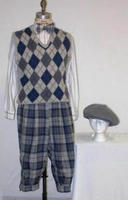 1.Seen in a San Francisco window display, hot fall fashion trend are knickers. 2. Playing in theater: The kids aren't all right, Patsy Cline once sang, "If I could see the world through the eyes of a child, what a wonderful world this would be." But those "Feed the Children" commercials tell a sadder story. Award-winning playwright Timothy Mason, who has built a career on tracing childhood suffering through turbulent periods in U.S. history, returns with the fourth installment in ACT's Young Conservatory New Plays Program, Mullen's Alley. Based on Jacob Riis' classic exposé How the Other Half Lives and featuring seven actors aged 13 to 17, the play chronicles the brutal hardships faced by youthful slum-dwellers in the Five Points neighborhood of Industrial Revolution-era New York City, where children are forced into harsh labor, even crime, in order to survive. Mullen's Alley opens Friday night at 7:30 (and continues through Aug. 28) at the Zeum Theater
1.Seen in a San Francisco window display, hot fall fashion trend are knickers. 2. Playing in theater: The kids aren't all right, Patsy Cline once sang, "If I could see the world through the eyes of a child, what a wonderful world this would be." But those "Feed the Children" commercials tell a sadder story. Award-winning playwright Timothy Mason, who has built a career on tracing childhood suffering through turbulent periods in U.S. history, returns with the fourth installment in ACT's Young Conservatory New Plays Program, Mullen's Alley. Based on Jacob Riis' classic exposé How the Other Half Lives and featuring seven actors aged 13 to 17, the play chronicles the brutal hardships faced by youthful slum-dwellers in the Five Points neighborhood of Industrial Revolution-era New York City, where children are forced into harsh labor, even crime, in order to survive. Mullen's Alley opens Friday night at 7:30 (and continues through Aug. 28) at the Zeum Theater
The Houses Are Different, The People The Same
 While walking through the Haight district the beautifully decorated De Avila school caught my eye. It was too good to be true. An article in the SF Chronicle pointed to the same problems we have in New York:"Sarah's, Arthur's and Julian's families did give the public school system a chance. They submitted a list of their top choices to the San Francisco Unified School District, which each winter runs a computerized lottery using those lists and a family's socioeconomic background to make assignments. The system is designed to ensure diversity in schools and is mandated by a federal court order. Since the Cole Valley families are middle-class and well-educated, their socioeconomic status worked against them in getting their children into the most popular, high-achieving elementary schools, including Rooftop, Lilienthal, Clarendon and Jefferson. Some might say that these are just the kinds of families the school district should be clamoring to keep, but all three families wound up being assigned to the struggling De Avila Elementary on Haight Street, which wasn't on their lists. The school is only about a half-mile from Cole Valley, but it enrolled mostly special education and homeless students and suffered from declining enrollment and poor test scores. None of the Cole Valley families considered it a viable option; the Board of Education didn't either, shutting it down in the spring in order to save money."
While walking through the Haight district the beautifully decorated De Avila school caught my eye. It was too good to be true. An article in the SF Chronicle pointed to the same problems we have in New York:"Sarah's, Arthur's and Julian's families did give the public school system a chance. They submitted a list of their top choices to the San Francisco Unified School District, which each winter runs a computerized lottery using those lists and a family's socioeconomic background to make assignments. The system is designed to ensure diversity in schools and is mandated by a federal court order. Since the Cole Valley families are middle-class and well-educated, their socioeconomic status worked against them in getting their children into the most popular, high-achieving elementary schools, including Rooftop, Lilienthal, Clarendon and Jefferson. Some might say that these are just the kinds of families the school district should be clamoring to keep, but all three families wound up being assigned to the struggling De Avila Elementary on Haight Street, which wasn't on their lists. The school is only about a half-mile from Cole Valley, but it enrolled mostly special education and homeless students and suffered from declining enrollment and poor test scores. None of the Cole Valley families considered it a viable option; the Board of Education didn't either, shutting it down in the spring in order to save money."
The House I Live In: San Francisco
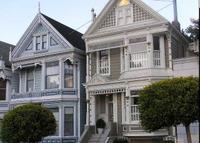 The house attached is of course the famous house of "Full House." What ever happened to predictibility?
The house attached is of course the famous house of "Full House." What ever happened to predictibility? The milkman, the paperboy, evening TV. Everywhere you look , everywhere you go (there's a heart). There's a heart
A hand to hold onto. Everywhere you look , everywhere you go.There's a face Of somebody who needs you. Eveywhere you look, When you're lost out there and you're all alone, A light is waiting to carry you home,Everywhere you look. Everywhere you look. It's located just off Alamo Square. Had a wonderful time here Here's a slide show of various San Francisco house styles.
The House I LIve In: New Orleans
 My first post back from San Francisco was going to be about the characteristic styles different cities have in houses and how that could be a topic worth pursuing. Somehow New Orleans' house styles take precedence-since these could be gone forever. Being in Berkeley and the Haight is good for the leftist soul, btcnews.com/btcnews/1093:"More than 3,000 members of the Louisiana National Guard’s 256th Brigade serving in Iraq can only watch from Baghdad as Hurricane Katrina bears down on their families and homes in New Orleans and the other south Louisiana communities from which they hail. The deployed soldiers and their equipment, which includes high water vehicles, Humvees and generators, will be sorely missed as Louisiana attempts to prepare for and recover from the historic Category Five storm. The soldiers of the 256th are due home in October, assuming their tour isn’t extended to beef up US troop levels in Iraq for the October constitutional referendum and December general elections. Mississippi and Alabama, the other states under threat from Katrina’s second assault on the Gulf Coast, also have Guard contingents in Iraq, with 3,500 troops of Mississippi’s 155th Brigade Combat Team serving near Karbala and Najaf, while 140 Alabama Guard troops left last Sunday for training preparatory to joining some 2,000 Alabama troops already deployed overseas. Governors throughout the country have watched anxiously as the Guard units they count on to see their states through natural disasters have been called up for service in Iraq, in many cases leaving behind tanks and other heavy armor while taking with them the kinds of equipment that are most valuable in coping with the aftermath of storms, floods and earthquakes. President Bush has already created one Gulf wasteland. In a few days he’ll be offering condolences to the residents of another; one he didn’t create, only stripped of its guardians in service of something he can’t even define." Here's a New Orleans' slide show
My first post back from San Francisco was going to be about the characteristic styles different cities have in houses and how that could be a topic worth pursuing. Somehow New Orleans' house styles take precedence-since these could be gone forever. Being in Berkeley and the Haight is good for the leftist soul, btcnews.com/btcnews/1093:"More than 3,000 members of the Louisiana National Guard’s 256th Brigade serving in Iraq can only watch from Baghdad as Hurricane Katrina bears down on their families and homes in New Orleans and the other south Louisiana communities from which they hail. The deployed soldiers and their equipment, which includes high water vehicles, Humvees and generators, will be sorely missed as Louisiana attempts to prepare for and recover from the historic Category Five storm. The soldiers of the 256th are due home in October, assuming their tour isn’t extended to beef up US troop levels in Iraq for the October constitutional referendum and December general elections. Mississippi and Alabama, the other states under threat from Katrina’s second assault on the Gulf Coast, also have Guard contingents in Iraq, with 3,500 troops of Mississippi’s 155th Brigade Combat Team serving near Karbala and Najaf, while 140 Alabama Guard troops left last Sunday for training preparatory to joining some 2,000 Alabama troops already deployed overseas. Governors throughout the country have watched anxiously as the Guard units they count on to see their states through natural disasters have been called up for service in Iraq, in many cases leaving behind tanks and other heavy armor while taking with them the kinds of equipment that are most valuable in coping with the aftermath of storms, floods and earthquakes. President Bush has already created one Gulf wasteland. In a few days he’ll be offering condolences to the residents of another; one he didn’t create, only stripped of its guardians in service of something he can’t even define." Here's a New Orleans' slide show
Wednesday, August 24, 2005
Essex Street 75 Years Ago
 The Sperr Collection gives us a remarkable view of the PS 20 site of 75 years ago. I wasn't aware that there was a widening of Essex Street that required the demolition of some of the buildings on the eastern side. I knew there was demolition due to the construction of the Essex Street market. Interesting that the demolition on the western side (between Stanton and Houston has never been reconstructed (the area where the parking lot now resides. Here's a slide show.
The Sperr Collection gives us a remarkable view of the PS 20 site of 75 years ago. I wasn't aware that there was a widening of Essex Street that required the demolition of some of the buildings on the eastern side. I knew there was demolition due to the construction of the Essex Street market. Interesting that the demolition on the western side (between Stanton and Houston has never been reconstructed (the area where the parking lot now resides. Here's a slide show.
Tuesday, August 23, 2005
Connecticut Heroes
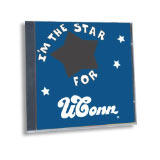 Connecticut Lawsuit Says 'No Child Left Behind' Is IllegalFrom Associated PressHARTFORD, Conn. — Connecticut on Monday became the first state to challenge the No Child Left Behind law in court, arguing that the centerpiece of President Bush's education law amounts to an unfunded mandate from the federal government."Our message today is: Give up the unfunded mandates, or give us the money," said state Atty. Gen. Richard Blumenthal. The lawsuit raises the stakes in a fight between states and the Bush administration over the law. Experts expect that legislatures around the country will be watching the case carefully, and that other states could vote to join the lawsuit or file their own.The lawsuit argues that No Child Left Behind is illegal because it requires standardized tests and other school programs that the government doesn't pay for. The suit asks a federal judge to declare that state and local money cannot be used to meet the law's goals.Education Secretary Margaret Spellings has repeatedly denied requests from Connecticut for more flexibility.If there's a bully on the playground, it often takes one brave soul to step forward and stand up to the bully," said state Rep. Andrew Fleischmann, co-chairman of the Legislature's Education Committee. he federal government is providing Connecticut with $5.8 million this fiscal year to pay for the testing, Sternberg said. She estimates federal funds will fall $41.6 million short of paying for costs associated with carrying out the law through 2008.The state is not the first entity to sue in response to No Child Left Behind. The National Education Assn., a teachers' union, filed a lawsuit in the spring on behalf of local districts and 10 state union chapters, including Connecticut."It is an interesting case," said Jack Jennings, president of the Washington-based Center on Education Policy. "It's interesting because a judge has to consider the fact that this is a state that's suing. It's not a school district. It's not a teachers' union. It's the state of Connecticut. So that adds a lot more gravity to the lawsuit."In Utah, the Legislature passed a measure defying the federal law, and it was signed by Gov. Jon Huntsman Jr.
Connecticut Lawsuit Says 'No Child Left Behind' Is IllegalFrom Associated PressHARTFORD, Conn. — Connecticut on Monday became the first state to challenge the No Child Left Behind law in court, arguing that the centerpiece of President Bush's education law amounts to an unfunded mandate from the federal government."Our message today is: Give up the unfunded mandates, or give us the money," said state Atty. Gen. Richard Blumenthal. The lawsuit raises the stakes in a fight between states and the Bush administration over the law. Experts expect that legislatures around the country will be watching the case carefully, and that other states could vote to join the lawsuit or file their own.The lawsuit argues that No Child Left Behind is illegal because it requires standardized tests and other school programs that the government doesn't pay for. The suit asks a federal judge to declare that state and local money cannot be used to meet the law's goals.Education Secretary Margaret Spellings has repeatedly denied requests from Connecticut for more flexibility.If there's a bully on the playground, it often takes one brave soul to step forward and stand up to the bully," said state Rep. Andrew Fleischmann, co-chairman of the Legislature's Education Committee. he federal government is providing Connecticut with $5.8 million this fiscal year to pay for the testing, Sternberg said. She estimates federal funds will fall $41.6 million short of paying for costs associated with carrying out the law through 2008.The state is not the first entity to sue in response to No Child Left Behind. The National Education Assn., a teachers' union, filed a lawsuit in the spring on behalf of local districts and 10 state union chapters, including Connecticut."It is an interesting case," said Jack Jennings, president of the Washington-based Center on Education Policy. "It's interesting because a judge has to consider the fact that this is a state that's suing. It's not a school district. It's not a teachers' union. It's the state of Connecticut. So that adds a lot more gravity to the lawsuit."In Utah, the Legislature passed a measure defying the federal law, and it was signed by Gov. Jon Huntsman Jr.
San Francisco
NYC-LES: Then and Now
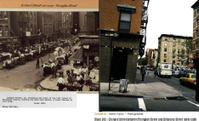 The NYPL can provide the raw materials for a then and now project, "a la Abbott." The Loomis-Sperr collection combined with an album of photos called, "Along the Yangtze River," allows you to match up the same blocks 70 years apart. I did that in one of slides in this slide show. Don't be fooled by the Yangtze River title-it's metaphoric.
The NYPL can provide the raw materials for a then and now project, "a la Abbott." The Loomis-Sperr collection combined with an album of photos called, "Along the Yangtze River," allows you to match up the same blocks 70 years apart. I did that in one of slides in this slide show. Don't be fooled by the Yangtze River title-it's metaphoric.BTW, there's a 1930 slide of the Baruch bath house mentioned two days ago.
The House I Live In: Tsunami Refugee Camp
 For their archives of free multimedia content the Washington Post and the LA Times have the New York papers beat. The Washington Post has a remarkable story on the recovety of a Sri Lankan fishing village named Weligama. Maps, panoramas video, and a blog are all part of the series. Here's a portion of a video about a 13 year old boy named K.M. Chathura Madhushanka.
For their archives of free multimedia content the Washington Post and the LA Times have the New York papers beat. The Washington Post has a remarkable story on the recovety of a Sri Lankan fishing village named Weligama. Maps, panoramas video, and a blog are all part of the series. Here's a portion of a video about a 13 year old boy named K.M. Chathura Madhushanka.
Monday, August 22, 2005
Santiago Molinas' House: Washington Heights
 There was an audio slide show that accompanied the NYTimes city section story of Santiago Molinas. Here's a part of it that I captured with snapzpro.
There was an audio slide show that accompanied the NYTimes city section story of Santiago Molinas. Here's a part of it that I captured with snapzpro.
The House I Live In: Ralph Fasanella
 "A second-generation Italian-American immigrant, Fasanella (1914-1997) painted what he knew: New York's garment industry, its diverse ethnographic make-up, trade unionism and grassroots American politics." Fasanella captured the struggles and triumphs of ordinary people in large, colorful, and detailed paintings. He painted them at home, at work and in the celebrations in their neighborhoods. Fasanella grew up in Little Italy. Maybe he went to the feast of Saint Rocco? Here's a slide show of his work. Many of the images come from a highly recommended site, bread-and-roses.com.
"A second-generation Italian-American immigrant, Fasanella (1914-1997) painted what he knew: New York's garment industry, its diverse ethnographic make-up, trade unionism and grassroots American politics." Fasanella captured the struggles and triumphs of ordinary people in large, colorful, and detailed paintings. He painted them at home, at work and in the celebrations in their neighborhoods. Fasanella grew up in Little Italy. Maybe he went to the feast of Saint Rocco? Here's a slide show of his work. Many of the images come from a highly recommended site, bread-and-roses.com.
The House I Live In: Edward Hopper
 It's been a while since we've looked at artist portrayals of home. Hopper was a realist like the ashcan artists. His scenes weren't as grim, although his subjects certainly were: "He excelled in creating realistic pictures of clear-cut, sunlit streets and houses, often without figures. In his paintings there is a frequent atmosphere of loneliness, an almost menacing starkness, and a clear sense of time of day or night." Here's a Hopper slide show.
It's been a while since we've looked at artist portrayals of home. Hopper was a realist like the ashcan artists. His scenes weren't as grim, although his subjects certainly were: "He excelled in creating realistic pictures of clear-cut, sunlit streets and houses, often without figures. In his paintings there is a frequent atmosphere of loneliness, an almost menacing starkness, and a clear sense of time of day or night." Here's a Hopper slide show.
The House I Live In: Housing Transformed
The House I Live In: Scholastic First Discovery Books
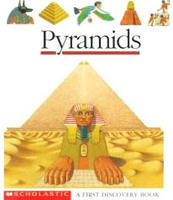 The image attached is for the pyramid book, but the slide show found here is about the first homes' book. Here's a review of the animal homes' book: Among the most popular subjects in preschool curriculum, animals and nature come to life in this sturdy board book that allows even 2-year-olds to "look ˇit-up." With die-cut pictorial tabs along the right-hand margin, children can point to the picture of an animal or object of interest to them, then turn to that spread and find out interesting facts through easy-to-understand captions and stunning, photo-realistic paintings. Part of the "First Discovery Look-It-Up" series, this sturdy, tabbed board book examines animal homes. It opens with a cut-away view of a rabbit burrow and explains what rabbits eat and that a mother can have a rather large brood of babies in her burrow. Many birds build nests and frequently line them with soft material to protect the eggs--moss and feathers are two of the examples cited. Other animals featured are ants, squirrels, polar bears, beavers and turtles, most of which will be familiar to young children eager to learn facts and take a closer look at the way these animals live and raise their families. The books in the series have a look and feel of the DK style--bright white pages, crisp images and a lucid text with facts, but not so much that it overwhelms the new readers. BTW, there's nothing wrong for an animal homes' study for lower grades-it's part of scope and sequence for science as well as social studies.
The image attached is for the pyramid book, but the slide show found here is about the first homes' book. Here's a review of the animal homes' book: Among the most popular subjects in preschool curriculum, animals and nature come to life in this sturdy board book that allows even 2-year-olds to "look ˇit-up." With die-cut pictorial tabs along the right-hand margin, children can point to the picture of an animal or object of interest to them, then turn to that spread and find out interesting facts through easy-to-understand captions and stunning, photo-realistic paintings. Part of the "First Discovery Look-It-Up" series, this sturdy, tabbed board book examines animal homes. It opens with a cut-away view of a rabbit burrow and explains what rabbits eat and that a mother can have a rather large brood of babies in her burrow. Many birds build nests and frequently line them with soft material to protect the eggs--moss and feathers are two of the examples cited. Other animals featured are ants, squirrels, polar bears, beavers and turtles, most of which will be familiar to young children eager to learn facts and take a closer look at the way these animals live and raise their families. The books in the series have a look and feel of the DK style--bright white pages, crisp images and a lucid text with facts, but not so much that it overwhelms the new readers. BTW, there's nothing wrong for an animal homes' study for lower grades-it's part of scope and sequence for science as well as social studies.
The House I Live In: OS 9 Technology
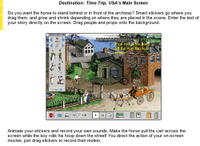 One issue that Adam, Arnie and I would like to deal with is providing appropriate software support for the project (or any project) with the classroom computer kiosks. Many of those machines are only capable of operating OS 9, likewise with the old blue clamshell laptops. We have some excellent software available with titles such as Destination Neighborhood, Destination Pyramid, Destination Rainforest, Destination Castle and Destination Time Trip. The kids can experiment with making scene changes and write stories about the scenes and the characters they place in them. There is also avoice recording and slide show component. Here's a slide show with some information.
One issue that Adam, Arnie and I would like to deal with is providing appropriate software support for the project (or any project) with the classroom computer kiosks. Many of those machines are only capable of operating OS 9, likewise with the old blue clamshell laptops. We have some excellent software available with titles such as Destination Neighborhood, Destination Pyramid, Destination Rainforest, Destination Castle and Destination Time Trip. The kids can experiment with making scene changes and write stories about the scenes and the characters they place in them. There is also avoice recording and slide show component. Here's a slide show with some information.
The House I Live In: The Old Admiral Houses of Fort Greene
 From the Times' city section. Again, the article as a pdf and a slide show with images from the Fort Greene Association site: fortgreeneny.com/
From the Times' city section. Again, the article as a pdf and a slide show with images from the Fort Greene Association site: fortgreeneny.com/
The House I Live In: Summers in the Dominican Republic
 From the Times' city section: The story of Santiago Molinas of Washington Heights who returned home to Villa Vazquez, D.R. this summer to be with his grandmother. Here's the pdf of the article and here's a slide show of typical Dominican homes. As mentioned in the previous posting I followed the same procedure. Here I was lucky to find a great site called dominicanimpressions.com
From the Times' city section: The story of Santiago Molinas of Washington Heights who returned home to Villa Vazquez, D.R. this summer to be with his grandmother. Here's the pdf of the article and here's a slide show of typical Dominican homes. As mentioned in the previous posting I followed the same procedure. Here I was lucky to find a great site called dominicanimpressions.com
The House I Live In: Homes Of India
 This is as simple as a search query in google or yahoo images like: homes of India, houses of India, home interiors of India, architecture of India, etc. Obviously this can be done for any country and you can just "pick off images." With snapzpro or by using key combinations you can capture the images with text. If you are lucky you can hit on a site that has a wealth of images and you can just "mine" that site. Of course in the age of globalization the homes in India can look just like homes here. Here's a slide show
This is as simple as a search query in google or yahoo images like: homes of India, houses of India, home interiors of India, architecture of India, etc. Obviously this can be done for any country and you can just "pick off images." With snapzpro or by using key combinations you can capture the images with text. If you are lucky you can hit on a site that has a wealth of images and you can just "mine" that site. Of course in the age of globalization the homes in India can look just like homes here. Here's a slide show
Indian Independence Day
 "The day when India woke up to freedom back in 1947 was a day of great celebration. A country got rid of her foreign yoke and became a sovereign nation, she celebrated her sovereignty on this day - the triumph of numerous martyred souls. It was a day of fulfillment, it was the day of a new beginning, a birth of a nation. On the stroke of midnight, a country came into life again as the British handed over the governance of India to the Indian leaders. The long and difficult struggle had borne fruit at last, though the happiness was marred by the fact that the country was divided into India and Pakistan and the violent communal riots had left the countries permanently scarred. That was the price that India paid for her dearly bought freedom. The British government declared the country independent and left for their own shores. On the 15th of August, 1947, India became completely independent. It was on this historic date that Jawaharlal Nehru, the first prime Minister of India, unfurled the Indian tricolor on the ramparts the magnificent Red Fort, symbolically marking the end of the British colonial rule." 123independenceday.com
"The day when India woke up to freedom back in 1947 was a day of great celebration. A country got rid of her foreign yoke and became a sovereign nation, she celebrated her sovereignty on this day - the triumph of numerous martyred souls. It was a day of fulfillment, it was the day of a new beginning, a birth of a nation. On the stroke of midnight, a country came into life again as the British handed over the governance of India to the Indian leaders. The long and difficult struggle had borne fruit at last, though the happiness was marred by the fact that the country was divided into India and Pakistan and the violent communal riots had left the countries permanently scarred. That was the price that India paid for her dearly bought freedom. The British government declared the country independent and left for their own shores. On the 15th of August, 1947, India became completely independent. It was on this historic date that Jawaharlal Nehru, the first prime Minister of India, unfurled the Indian tricolor on the ramparts the magnificent Red Fort, symbolically marking the end of the British colonial rule." 123independenceday.com
Baruch Bathouse
 8/20/05: With their little arms raised high in the air, about 50 children stood on the steps of the abandoned Baruch Houses bathhouse in the Lower East Side on Monday afternoon in the rain, shouting chants and holding homemade poster board signs in support of Michael Beys, a candidate for City Council in District 2.“When do we want a recreation center!” shouted Beys. “Now!” replied the children in unison. “How are we going to do it?” said Beys. “Together!” they yelled. Beys, smiling for photos next to the kids, said he wants to make the renovation of the Baruch bathhouse a “top priority” if he is elected. The building, which he called “dilapidated,” has been ignored for too long, and a community center would be a great use of the underutilized space, he said. The bathhouse, first built in 1901, housed an outdoor pool as well as separate showers and tubs for men and women. After falling into disrepair, the bathhouse was shut down in 1975 during a time of fiscal crisis, said a Parks Department spokesperson. The building’s windows are now encased in cinderblocks and its facade is covered with graffiti. The Parks Department, which owns the property, does not have the funds to renovate and maintain the bathhouse. It would be a tremendous undertaking and would most likely cost far more than tens of millions of dollars — although no formal assessment has ever been done — a Parks spokesperson said. However, if there is public interest and sufficient funding is made available, it would be something they would definitely consider. For now, Parks is currently constructing new turf playing fields at Baruch Playground. Not it all makes sense what Manny was saying in Josh Pais' film (7/31/05 posting) He said he went swimming at the Columbia Street pool and had to watch out getting drowned by Italian kids. The Baruch pool was near Columbia and Rivington.
8/20/05: With their little arms raised high in the air, about 50 children stood on the steps of the abandoned Baruch Houses bathhouse in the Lower East Side on Monday afternoon in the rain, shouting chants and holding homemade poster board signs in support of Michael Beys, a candidate for City Council in District 2.“When do we want a recreation center!” shouted Beys. “Now!” replied the children in unison. “How are we going to do it?” said Beys. “Together!” they yelled. Beys, smiling for photos next to the kids, said he wants to make the renovation of the Baruch bathhouse a “top priority” if he is elected. The building, which he called “dilapidated,” has been ignored for too long, and a community center would be a great use of the underutilized space, he said. The bathhouse, first built in 1901, housed an outdoor pool as well as separate showers and tubs for men and women. After falling into disrepair, the bathhouse was shut down in 1975 during a time of fiscal crisis, said a Parks Department spokesperson. The building’s windows are now encased in cinderblocks and its facade is covered with graffiti. The Parks Department, which owns the property, does not have the funds to renovate and maintain the bathhouse. It would be a tremendous undertaking and would most likely cost far more than tens of millions of dollars — although no formal assessment has ever been done — a Parks spokesperson said. However, if there is public interest and sufficient funding is made available, it would be something they would definitely consider. For now, Parks is currently constructing new turf playing fields at Baruch Playground. Not it all makes sense what Manny was saying in Josh Pais' film (7/31/05 posting) He said he went swimming at the Columbia Street pool and had to watch out getting drowned by Italian kids. The Baruch pool was near Columbia and Rivington.
Berenice Abbott, Then And Now
 It was inevitable that some one would take on this project. What also could be done is a then and now,part 2 project with many of the Dover titles that Abbott contributed to. Here's the whole article as a pdf from the downtown express
It was inevitable that some one would take on this project. What also could be done is a then and now,part 2 project with many of the Dover titles that Abbott contributed to. Here's the whole article as a pdf from the downtown express
Sunday, August 21, 2005
LES Hero
 Steven Vincent came back to the East Village from Iraq last week, about the time he had been planning to. Vincent, 49, had intended to come home to E. 11th St. this month to work on a book on the historic city of Basra, from where he had been reporting. But on Aug. 2 he was kidnapped and shot to death by masked gunmen in that city, becoming the first American journalist to be attacked and killed in the Iraq war. It’s believed his exposés on the rise of Shiite fundamentalists and insurgents in Basra are what led to his death. Here's an article from the villager
Steven Vincent came back to the East Village from Iraq last week, about the time he had been planning to. Vincent, 49, had intended to come home to E. 11th St. this month to work on a book on the historic city of Basra, from where he had been reporting. But on Aug. 2 he was kidnapped and shot to death by masked gunmen in that city, becoming the first American journalist to be attacked and killed in the Iraq war. It’s believed his exposés on the rise of Shiite fundamentalists and insurgents in Basra are what led to his death. Here's an article from the villager
The House I Live In: Habitat For Humanity
 I don't why I didn't think of looking on their site before in regard to the home's theme. This worthy organization builds houses in different styles depending on the character of the neighborhood and consistent with kinds of building materials traditionally used. They also attempt to be energy saving. Here's a slide show from the site.
I don't why I didn't think of looking on their site before in regard to the home's theme. This worthy organization builds houses in different styles depending on the character of the neighborhood and consistent with kinds of building materials traditionally used. They also attempt to be energy saving. Here's a slide show from the site.
Little Italy Extension
 The feast of San Rocco, whuch was viewed in the last posting's slide show, was celebrated in August. The parade started in Little Italy and proceeded south on James Street and turned east on Cherry toward Catherine. The neighborhood was solidly Italian. Region 9's lovely Denise Vispisiano told me her grandfather lived in the area and had a fruit stand. I found the family on Hamilton Street, (which crossed Catherine). Notice that every one of the families on this block comes from Italy. So Who Is St. Rocco?: St. Rocco is the patron saint of Patrica, a small town in central Italy and the home of many immigrants who came here to 4th Ward in the early part of the 20th Century. Those Italian workers brought with them this tradition of honoring the 14th-century holy man with music, prayers and a procession. Saint Rocco is venerated in the Roman Catholic Church as the protector against the plague and all contagious diseases. The statue of Saint Rocco is considered unique among theologians because of his pose. It is most unusual because it depicts him with his left hand pointing to an open sore on his left leg. Few images of saints expose any afflictions or handicaps. His body is enclosed in a glass tomb in the church of San Rocco in Venice, Italy. The commemoration the death of this great follower of Christ is held on August 16th of each year.
The feast of San Rocco, whuch was viewed in the last posting's slide show, was celebrated in August. The parade started in Little Italy and proceeded south on James Street and turned east on Cherry toward Catherine. The neighborhood was solidly Italian. Region 9's lovely Denise Vispisiano told me her grandfather lived in the area and had a fruit stand. I found the family on Hamilton Street, (which crossed Catherine). Notice that every one of the families on this block comes from Italy. So Who Is St. Rocco?: St. Rocco is the patron saint of Patrica, a small town in central Italy and the home of many immigrants who came here to 4th Ward in the early part of the 20th Century. Those Italian workers brought with them this tradition of honoring the 14th-century holy man with music, prayers and a procession. Saint Rocco is venerated in the Roman Catholic Church as the protector against the plague and all contagious diseases. The statue of Saint Rocco is considered unique among theologians because of his pose. It is most unusual because it depicts him with his left hand pointing to an open sore on his left leg. Few images of saints expose any afflictions or handicaps. His body is enclosed in a glass tomb in the church of San Rocco in Venice, Italy. The commemoration the death of this great follower of Christ is held on August 16th of each year.
Saturday, August 20, 2005
The House I Live In: Washington D.C. Civil War Era
 Part 5 of the Washington Post series. Converted here to a slide show.
Part 5 of the Washington Post series. Converted here to a slide show.
KV Memories
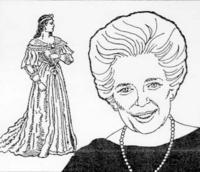 It's strange how people remember different things about the past. Richard Karney didn't remember that Simmons kept a baby food jar on his desk in the sixth grade and had it labeled as containing "Paul Lutz's fart." I didn't remember how we watched the news of Kennedy's assassination from the television in the butcher shop on Monroe Street. But it just came to me in a flash a few seconds ago, the name of the opera singer who lived upstairs. She was Judith Raskin: "A Great Lyric Soprano, Judith Raskin was one of America's greatest lyric sopranos of the twentieth century. She was not only famous for her voice but also for her acting. She was born on June 21, 1928, to Lillian and Harry A. Raskin. Her mother was a grade school teacher and her father was a high school music teacher. It was her father who aroused Judith's interest in music. As a child, she studied the violin and piano. Later, singing became the focus of her musical interest. She graduated Roosevelt High School in Yonkers, New York, in 1945, and then entered Smith College in Northhampton, Massachusetts where she majored in music. She started taking singing lessons while at college. After graduation, she continued taking lessons as her voice displayed great warmth and artistry. She won the Marian Anderson award for 1952 and 1953. She began making appearances on the concert stage throughout the country. Raskin first received national recognition when in 1957 she sang in the televised American premier performance of Poulenc's "Dialogues des Carmelites." In July of 1957, she performed a concert version of Puccini's "La Boheme" with the Symphony of the Air in New York City's Central Park. After many concerts, she joined the New York City Opera Company and made her debut in Mozart's "Cosi Fan Tutte" in 1959. In February, 1960 she sang the title role in Douglas Moore's "Ballad of Baby Doe" for the New York City Opera. The Herald Tribune reviewer thought that her beauty, acting and great voice made it hard to believe that she could be the "sweetheart" of miners on Colorado. The pinnacle of her career came on February 23, 1962, when Raskin made her debut at the Metropolitan Opera House in the role of Susanna in Mozart's "Marriage of Figaro." She was hailed by the critics for her outstanding performance. Through the years she continued singing in concerts, ensembles and in operas. She felt that Strauss and Mozart roles were the best for her voice. During this period, she campaigned for more opera companies in the cities. She was quoted as saying "What we get Is well trained American singers with no place to go. The only way to become professional is to perform." She married Dr. Raymond A. Raskin on July 11, 1948. They had two children, Jonathon, who became a medical internist, and Lisa, who was an associate professor of psychology at Amherst College. Through careful planning, Judith Raskin managed to have a happy marital and family life as well as a career. She became an instructor at the Manhattan School of Music. In 1979, she taught at the 92nd Street YM-YWHA, where she sang the role of Pearl, the rabbi's wife in the new opera "The Golem." Raskin was active in many music advisory boards, the Young Concert Artists, the National Opera Institute and the National Endowment of the Arts. During her career, she recorded for Columbia, London, Decca, RCA Victor and CRI Records. Judith Raskin died on December 21, 1984, after a long struggle with cancer. Services were held at the Stephen Wise Free Synagogue in New York City where she was eulogized as being one of the finest artists of our time who could be emulated by other future Jewish aspirants of the concert and opera stage."
It's strange how people remember different things about the past. Richard Karney didn't remember that Simmons kept a baby food jar on his desk in the sixth grade and had it labeled as containing "Paul Lutz's fart." I didn't remember how we watched the news of Kennedy's assassination from the television in the butcher shop on Monroe Street. But it just came to me in a flash a few seconds ago, the name of the opera singer who lived upstairs. She was Judith Raskin: "A Great Lyric Soprano, Judith Raskin was one of America's greatest lyric sopranos of the twentieth century. She was not only famous for her voice but also for her acting. She was born on June 21, 1928, to Lillian and Harry A. Raskin. Her mother was a grade school teacher and her father was a high school music teacher. It was her father who aroused Judith's interest in music. As a child, she studied the violin and piano. Later, singing became the focus of her musical interest. She graduated Roosevelt High School in Yonkers, New York, in 1945, and then entered Smith College in Northhampton, Massachusetts where she majored in music. She started taking singing lessons while at college. After graduation, she continued taking lessons as her voice displayed great warmth and artistry. She won the Marian Anderson award for 1952 and 1953. She began making appearances on the concert stage throughout the country. Raskin first received national recognition when in 1957 she sang in the televised American premier performance of Poulenc's "Dialogues des Carmelites." In July of 1957, she performed a concert version of Puccini's "La Boheme" with the Symphony of the Air in New York City's Central Park. After many concerts, she joined the New York City Opera Company and made her debut in Mozart's "Cosi Fan Tutte" in 1959. In February, 1960 she sang the title role in Douglas Moore's "Ballad of Baby Doe" for the New York City Opera. The Herald Tribune reviewer thought that her beauty, acting and great voice made it hard to believe that she could be the "sweetheart" of miners on Colorado. The pinnacle of her career came on February 23, 1962, when Raskin made her debut at the Metropolitan Opera House in the role of Susanna in Mozart's "Marriage of Figaro." She was hailed by the critics for her outstanding performance. Through the years she continued singing in concerts, ensembles and in operas. She felt that Strauss and Mozart roles were the best for her voice. During this period, she campaigned for more opera companies in the cities. She was quoted as saying "What we get Is well trained American singers with no place to go. The only way to become professional is to perform." She married Dr. Raymond A. Raskin on July 11, 1948. They had two children, Jonathon, who became a medical internist, and Lisa, who was an associate professor of psychology at Amherst College. Through careful planning, Judith Raskin managed to have a happy marital and family life as well as a career. She became an instructor at the Manhattan School of Music. In 1979, she taught at the 92nd Street YM-YWHA, where she sang the role of Pearl, the rabbi's wife in the new opera "The Golem." Raskin was active in many music advisory boards, the Young Concert Artists, the National Opera Institute and the National Endowment of the Arts. During her career, she recorded for Columbia, London, Decca, RCA Victor and CRI Records. Judith Raskin died on December 21, 1984, after a long struggle with cancer. Services were held at the Stephen Wise Free Synagogue in New York City where she was eulogized as being one of the finest artists of our time who could be emulated by other future Jewish aspirants of the concert and opera stage."
Friday, August 19, 2005
The House I Live In: Wasington D.C. 1850's
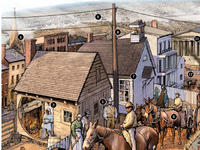 A look at life in Washington D.C. in the 1850's from the Washington Post. The pdf poster was broken up to make a slide show
A look at life in Washington D.C. in the 1850's from the Washington Post. The pdf poster was broken up to make a slide show
The House I Live In: Floor Plans
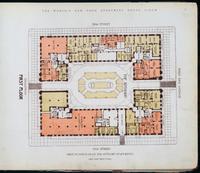 The nypl digital collection has floor plans of the "classic 6" apartments of several of the beautiful old upper west side buildings. Researching these could add another component to the housestudy. Kids could even design their own floor plans.Here's the slide show
The nypl digital collection has floor plans of the "classic 6" apartments of several of the beautiful old upper west side buildings. Researching these could add another component to the housestudy. Kids could even design their own floor plans.Here's the slide show
Social Studies Textbooks: Heinemann
 Sally Senzell Isaacs is the illustrator of for much of Heinemann's new Raintree Collection. They have titles such as America's Journey and the American Adventure. Graphically rich very much like Usborne and DK. "The American Adventure, This series helps readers explore our nation's past by focusing on key events in history that shaped our country and established Americans' reputation for adventure and exploration. All spreads employ clear layouts that explore important issues of the time - social, political, and economic - and the influence that these issues had on the nation's future."Here's a slide show provides a glimpse of some of the pages along with many of the covers from Senzell Isaacs' "Picturing The Past" books.
Sally Senzell Isaacs is the illustrator of for much of Heinemann's new Raintree Collection. They have titles such as America's Journey and the American Adventure. Graphically rich very much like Usborne and DK. "The American Adventure, This series helps readers explore our nation's past by focusing on key events in history that shaped our country and established Americans' reputation for adventure and exploration. All spreads employ clear layouts that explore important issues of the time - social, political, and economic - and the influence that these issues had on the nation's future."Here's a slide show provides a glimpse of some of the pages along with many of the covers from Senzell Isaacs' "Picturing The Past" books.
Stan Mack's Real Life Revolution

Stan Mack, the cartoonist of Village Voice fame, also wrote a relatively unknown cartoon book about the Revolutionary War and its aftermath. Here's a review: "Longtime Village Voice cartoonist Mack has taken his talent for rendering the frenzied variety of life in New York City and produced a cheerful and informative history of the American Revolution. Delightfully illustrated in his distinctive minimalist cartoon style, Mack's first original book-length effort puts the "real life" back into our revolutionary roots, providing capsule portraits of the prominent activists of the time, along with their many idiosyncracies, comic flaws and strategic bungling. He provides amusing sketches of early anti-British activists like James Otis and Sam Adams, notes the nature of the Enlightenment and New England Puritanism and outlines the many hated tax laws that preceded the Boston Tea Party and the Revolutionary War. Just as important, he depicts the ongoing clashes between the colonial aristocracy, new merchant classes, urban laborers and farmers over the country's developing economy. He also profiles the important but restricted roles of African slaves and freemen and women in the war, as well as the formidable presence of Native American nations. Ending with the ratification of the Constitution, Mack celebrates the document while pointing to its flaws-the continuance of slavery, destruction of native cultures and lack of rights for women and whites without property.Here's a slide show of a portion.
Homes and Houses Then and Now
 Another Usborne winner done in a now and then format. Review: A fun and dynamic way to learn about the history of homes and houses. Fold-out flaps on every double page compare homes and houses then and now, taking the reader back through time. The cartoon-style illustrations and text show how the ancient Egyptians stayed cool in the summer, where the chief of a Viking village lived and much more. Here's a slide show showing Cave Era, Egypt and Rome comparisons.
Another Usborne winner done in a now and then format. Review: A fun and dynamic way to learn about the history of homes and houses. Fold-out flaps on every double page compare homes and houses then and now, taking the reader back through time. The cartoon-style illustrations and text show how the ancient Egyptians stayed cool in the summer, where the chief of a Viking village lived and much more. Here's a slide show showing Cave Era, Egypt and Rome comparisons.
Thursday, August 18, 2005
Very Dense
Heroic
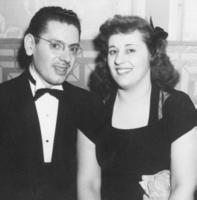 The guy on the left wasn't a LES hero but he did manage to survive the depression without a father, a bout with rheumatic fever, 3 heart valve replacement surgeries, cancer, and muscular dystrophy and he worked until he was 79 years old. He also graduated from PS 20. Here's a slide show-the first slide was where he lived as a kid, 122 Orchard Street
The guy on the left wasn't a LES hero but he did manage to survive the depression without a father, a bout with rheumatic fever, 3 heart valve replacement surgeries, cancer, and muscular dystrophy and he worked until he was 79 years old. He also graduated from PS 20. Here's a slide show-the first slide was where he lived as a kid, 122 Orchard Street
The House I Live In: Magic School Bus Goes History

Maybe Joanna Cole and Bruce Degen heard about the "rediscovery" of social studies. Their most recent titles cover China, Egypt, Castles. A review of China:"Grade 2-5–Ms. Frizzle is off to Imperial China in this spin-off series in which she travels through time to bygone cultures. During a Chinese New Year's celebration, the teacher; a Chinese-American student, Wanda; Wanda's older brother Henry; and the ever-reluctant Arnold travel back in time 1000 years and arrive in a farmers' village. While there, they learn to grow rice, eat with chopsticks, and make silk. Ms. Frizzle is as curious and irrepressible as ever as she and her students travel north by barge, cart, and foot to the Great Wall and finally to the capital city. The endnotes explain which aspects of the story are historically accurate and where the author and illustrator have taken small liberties. The cartoon illustrations, done in a mix of pen and ink, watercolor, and colored pencil and gouache, continue the frenetic, zany humor of the Magic School Bus series. Small panels on each page highlight facts about Imperial China, such as items first invented in China, how to bow, and the basics of writing. Like previous books featuring Ms. Frizzle, this one is destined to find an avid audience and may spark interest in Chinese culture." Here's a slide show
The House I Live In: Jack's House
 There was a funeral home on Coney Island Avenue named Jack Yablokoff. Nuff said. This is great for early gades. The limerick comes from the enchanted learning site (a great resource-I sprung for a membership). Here's a slide show with the limerick and parts of the Simm's Taback book. A review: "From School Library Journal PreSchool-Grade 2-Taback is very, very clever. He takes the house element of the story literally by turning the endpapers and back cover into newspaper advertisements, offering real estate and tools to fix a house. The adventure inside is downright hilarious. "This is the cheese that lay in the house" elicits an entire page on which various cheeses are not only named but also labeled as to their aroma or lack of it. Every page contains a variety of tongue-in-cheek references that may go over the heads of some kids but those who get them will love them. The illustrator creates additional drama with strong color. He uses stark black backgrounds for the house painted in bright jewel tones. Dark colors, such as navy and deep green, lay the groundwork for each of the characters. The rat, the cat, the dog, etc., all have their own pages and their names are formed by letters cut from newspapers. Children will love this book, and it's a natural for storyhour. This is the version every library should have."
There was a funeral home on Coney Island Avenue named Jack Yablokoff. Nuff said. This is great for early gades. The limerick comes from the enchanted learning site (a great resource-I sprung for a membership). Here's a slide show with the limerick and parts of the Simm's Taback book. A review: "From School Library Journal PreSchool-Grade 2-Taback is very, very clever. He takes the house element of the story literally by turning the endpapers and back cover into newspaper advertisements, offering real estate and tools to fix a house. The adventure inside is downright hilarious. "This is the cheese that lay in the house" elicits an entire page on which various cheeses are not only named but also labeled as to their aroma or lack of it. Every page contains a variety of tongue-in-cheek references that may go over the heads of some kids but those who get them will love them. The illustrator creates additional drama with strong color. He uses stark black backgrounds for the house painted in bright jewel tones. Dark colors, such as navy and deep green, lay the groundwork for each of the characters. The rat, the cat, the dog, etc., all have their own pages and their names are formed by letters cut from newspapers. Children will love this book, and it's a natural for storyhour. This is the version every library should have."
Subscribe to:
Posts (Atom)
